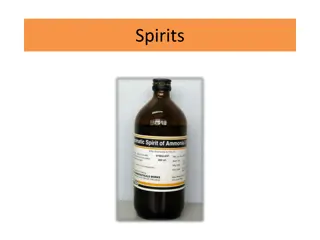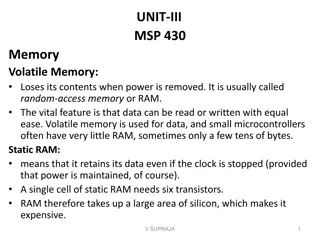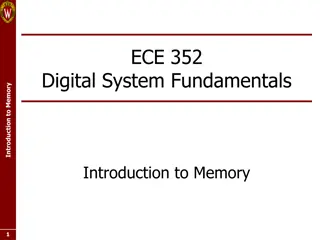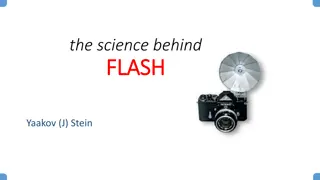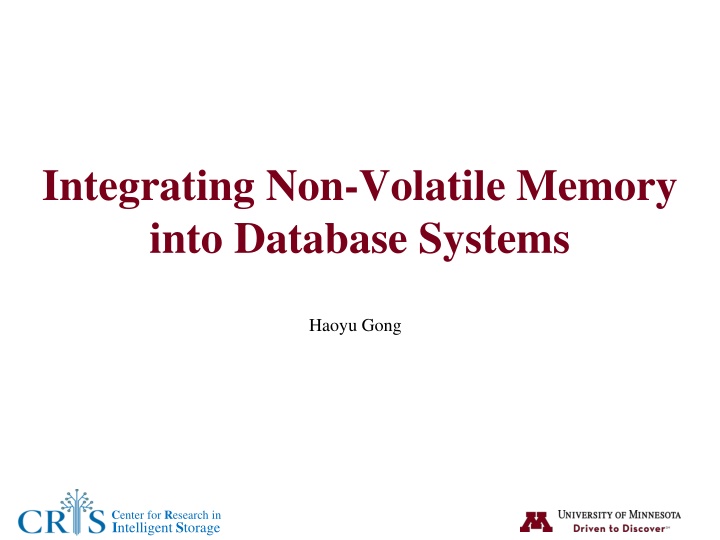
Integrating Non-Volatile Memory into Database Systems for Enhanced Performance
Discover how integrating non-volatile memory (NVM) into database systems revolutionizes performance with features like byte-addressability, high write throughput, and persistent writes. Learn about the key components and challenges associated with NVM-aware database management systems.
Download Presentation

Please find below an Image/Link to download the presentation.
The content on the website is provided AS IS for your information and personal use only. It may not be sold, licensed, or shared on other websites without obtaining consent from the author. If you encounter any issues during the download, it is possible that the publisher has removed the file from their server.
You are allowed to download the files provided on this website for personal or commercial use, subject to the condition that they are used lawfully. All files are the property of their respective owners.
The content on the website is provided AS IS for your information and personal use only. It may not be sold, licensed, or shared on other websites without obtaining consent from the author.
E N D
Presentation Transcript
Integrating Non-Volatile Memory into Database Systems Haoyu Gong Center for Research in Intelligent Storage
New Non-Volatile Memory DRAM-like Performance Byte-addressable Persistent Writes Large storage Capacity Center for Research in Intelligent Storage
Motivation Two Types of DBMS o Disk-oriented systems o Memory-oriented systems Key Assumption o The difference in the performance characteristics of volatile (DRAM) and non-volatile storage devices (HDD/SSDs) influences the design of database management systems (DBMSs). o The latter is much slower than the former. Characteristics of NVM o Byte-Addressability o High Write Throughput o Persistent Writes o Read-Write Asymmetry Center for Research in Intelligent Storage
NVM-Aware Components The main components of a DBMS that are affected by NVM Center for Research in Intelligent Storage
Access Interfaces o Allocator Interface o Filesystem Interface Storage Manager o Access Methods o Logging & Recovery o Data Placement o Replication Execution Engine o Plan Executor o Query Optimizer o SQL extensions Center for Research in Intelligent Storage
Access Interfaces Two Access Interfaces o Allocator Interface o Filesystem Interface Pros & Cons o Filesystem interface supports a naming mechanism o Allocator interface does not automatically provide a naming mechanism o Filesystem interface requires the application s writes to go through the kernel s virtual filesystem (VFS) layer o Allocator interface can write to and read from NVM directly within user space Center for Research in Intelligent Storage
Access Interfaces Design NVM-aware Memory Allocator Allocator Interface o Durability mechanism o Naming mechanism o Atomicity mechanism Programming Challenges with NVM o Data consistency o Data recovery o Persistent memory leaks o Partial writes o Persistent memory fragmentation o Address space fragmentation Center for Research in Intelligent Storage
Access Interfaces o Allocator Interface o Filesystem Interface Storage Manager o Access Methods o Logging & Recovery o Data Placement o Replication Execution Engine o Plan Executor o Query Optimizer o SQL extensions Center for Research in Intelligent Storage
Storage Manager Access Methods o NVM-Aware B+tree index High overhead for consistency guarantee Slow data recovery after system restart o Related Work NV-tree wB+tree FPtree o Hash Index High overhead for consistency guarantee Performance Degradation for Reducing Writes Cost Inefficiency for Resizing Hash Table Center for Research in Intelligent Storage
Storage Manager Logging & Recovery o WAL(Write Ahead Log) o Unnecessary data duplication o NVM enables a better logging protocol than WAL o Higher write throughput o Smaller gap between sequential writes and random writes o Byte-addressability o Related Work o WBL(Write Behind Log): records the tuple s contents in the database even before it writes any associated meta-data in the log. Center for Research in Intelligent Storage
Storage Manager Data Placement o The impact of dynamic data placement on a multi-tier storage hierarchy containing NVM must be explored in future work. Center for Research in Intelligent Storage
Storage Manager Replication o Types of Failure o Transaction Failure o System Failure o Media Failure o These failures are instead overcome through replication o Expect logging scheme designed for NVM in this replicated environment. Center for Research in Intelligent Storage
Access Interfaces o Allocator Interface o Filesystem Interface Storage Manager o Access Methods o Logging & Recovery o Data Placement o Replication Execution Engine o Plan Executor o Query Optimizer o SQL extensions Center for Research in Intelligent Storage
Execution Engine Plan Executor o Need to redesign the algorithms backing the relational operators to reduce the number of writes to durable storage, given the read-write asymmetry and limited write-endurance of NVM. (sort, join) Query Optimizer o Differentiate between reads and writes, and take into consideration the convergence of sequential and random accesses in NVM. o Adapted cost functions should account for the byte-addressability of NVM. SQL Extensions o The DBMS contains certain SQL extensions to allow the user to control data placement on NVM. Center for Research in Intelligent Storage
Conclusion The advent of NVM invalidates the long-held assumption that durable storage is several orders of magnitude slower relative to the DRAM. It is important to reexamine the design choices made in different components of the DBMS to leverage the raw device performance differential. Center for Research in Intelligent Storage
Thank you! Haoyu Gong Center for Research in Intelligent Storage



